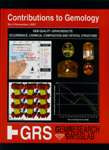OCCURRENCE OF JOHACHIDOLITE
Johachidolite is found in the Pain Pyit mining province,
which is located about 5 km northeast of Mogok (Fig.
J02, JO5, J11 and J17). The Pain Pyit mining province
is famous for its findings of gem quality spinels
(Fig. J13), sapphire and other collector gemstones
(Tab. J01, Box J01). Rubies are also found, but mostly
in other areas of Mogok (Fig. J09 and J10). Recently,
mining of other minerals has gained importance in
the Pain Pyit area. The locality of johachidolite
occurrence is called Pyant Gyi and is also situated
in the Pain Pyit minerals province (coordinates are
given on Fig. JO2, J17 and J19). Previously, the mining
at Pyant Gyi was targeted on gem quality pinkish-red
spinels and pink johachidolite material, mined before
August 2007, was scapolite (See Tab. J01 and Box.
J01). The Pyant Gyi mine was already active in the
1980’s to 1990’s, when rubies, Sapphires
and spinels were found in 2000, the mining activities
incresed, when attenntion turned to the findings of
spinels of vibrant pinkish-red color.
|
|
In 2005, about 30 miners were searching at this
mine for collector stones (Fig. J16), in particular
for clean pink scapolite. Some of the material
thought to be scapolite, turned out to be poudretteite,
as first recognized by one of the authors (NLT)
during gemological testing in Mogok. The discovery
of gem quality hackmanite (Box JO1) at this
mine in 2005 initiated a mining boom (Fig. J16
and J19), which lead to more findings of other
gem (Box JO1). Hackmanite-containing rocks were
mining hammered to retrieve hackmanite with
no attention to
the yellow to orange colored johachidolite.
Most of the johachidolite material, mined before
August 2007, was lost (*).
...............................................................................................................
|
(*) Just
before printing this report, one of the authors
(FP) was able to acquire hackmenite-bearing
pegnatite at the Munich Mineral Show (2007),
obviously corresponding to the materials found
in Mogok. The rock specimens also contained
additional johachidolite . |
|




